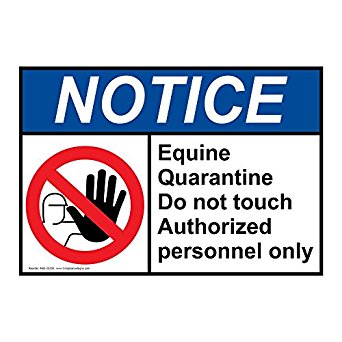Bio-security Basics
18th Mar 2018
Previously on the blog, we discussed ways to lower your horse’s risk of catching an infectious disease such as EHV-1 or Potomac Horse Fever. But what happens if an illness is already in your barn? Here are some steps to take to keep infection contained and at bay.

Call the Vet – This step is obvious but will be the basis of all containment protocols for an outbreak. Each disease and disease-causing agents spread in different and specific ways, so identifying the source is paramount.
Communication – A barn quarantine can put a lot of stress on you, workers at the barn, and fellow boarders. Having checklists available that include what order to feed and clean in, as well as temperature checking schedules and appointments for sick horses can take the second guessing out of everyone’s routines. If your barn has boarders it is important to have a meeting and let this information be publicly available, so the quarantine protocol is understood by all.
Isolation – Sick horses should be isolated from healthy horses immediately, especially foals, pregnant mares, and elderly horses. If possible moving the horse to a separate part of the property is ideal and limiting contact only to essential caregivers. If isolation is not possible, limit all contact to only an essential few. Be sure to continue monitoring healthy horses.
Separate Equipment – Care for the sick horse (feed, stall mucking, meds) after caring for the other horses and use separate equipment or disinfect equipment thoroughly after use. It’s best to also have a change of clothes for when dealing with the infected horse. Disposable gloves, shoe covers and a disinfecting foot bath will make life a lot easier.
Outside Deliveries – You or your Barn’s Manager will need to make plans regarding outside deliveries like feed and shavings. Will a new shipment be arriving within the mandatory quarantine period? Will you need to designate a central drop off? Or if the delivery truck is going into the quarantined area, are they taking precautions not to spread to other areas of the stable or barn?
Be Patient – As the sick horse recovers, wait for the green light from your veterinarian before you return him or her to the group. Your horse may be on the mend but they could still be contagious.
When your horse is in the clear and isolation is over. Be sure to thoroughly strip and disinfect the stall and all equipment. Disinfection guidelines can be found online ( UC Davis Equine Facility Biosecurity Guidelines PDF). You can get free e-mail alerts on infectious disease outbreaks and updates through Equine Disease Communication Center by joining their mailing list.
